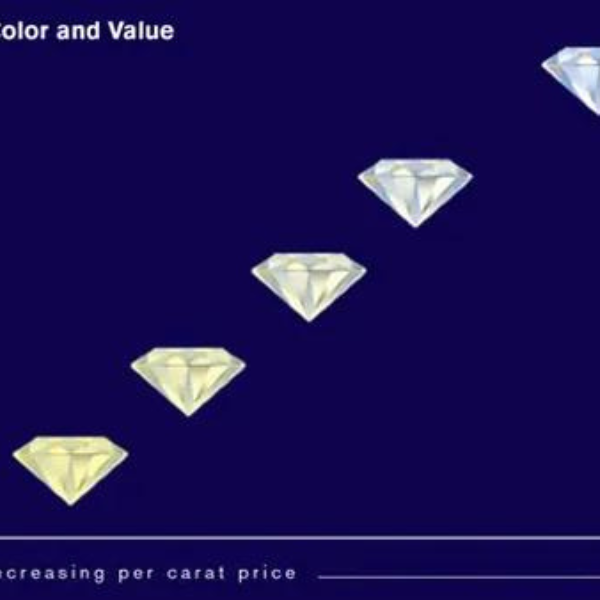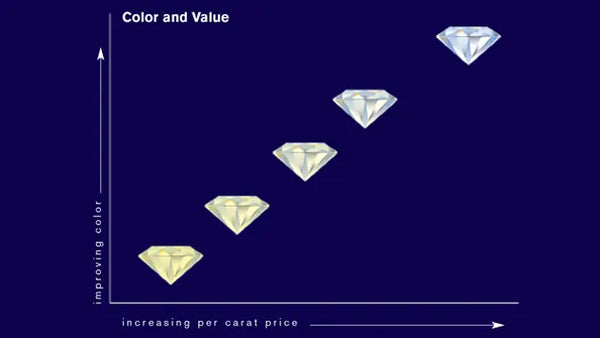
Every diamond is a unique creation of pressure, composition, and time. Each of these valuable stones has a variety of factors which affect price, including size, shape, color, and various internal characteristics. How then, can the global market standardize diamonds to make comparison and cataloging equal? One globally accepted answer arrived in the 1950s when diamond professionals developed the GIA grading system, which established the use of four important characteristics to describe and classify diamonds.
You have probably heard of these four factors, they have evolved with the cultural conscience to become widely known by everyone shopping for an engagement ring or diamond pendant. We are talking, of course, about “the four C’s”. Color, Clarity, Cut, and Carat weight are the four factors which have the greatest impact on diamond prices and are each graded according to the GIA standards.
When exploring your options for a beautiful diamond we suggest focusing on the factors most important to you and choosing a diamond that satisfies your individual standards for beauty and value.

Photo credit: gia.edu
Color
Color is arguably the most important factor of a diamond. Gem-quality diamonds are evaluated on the absence of color. While there is a market for colored diamonds, traditional value is assessed based on a diamond grading scale from a gem lab. The American Gem Society (AGS) and European Gemological Laboratory (EGL) both grade diamonds based on color, but the most widely recognized and respected grading system comes from the Gemological Institute of America (GIA).
GIA graded diamonds are carefully evaluated by at least four expert gemologists who are chosen at random to guarantee unbiased evaluations of each stone. The GIA scale denotes color grades by letter, starting with D (the highest grade) and moving all the way to Z (the lowest color grade). On the GIA Scale, diamonds which receive a grade of D, E, or F are referred to as Colorless. Colorless diamonds are rare, most diamonds have hints of yellow or brown tint when evaluated for color, making these highly graded stones very valuable.
Two diamonds which receive the same grades for clarity, weight, and cut can differ dramatically in price based on their respective color grade. Even the slightest hint of color can impact value, with many distinctions in color so subtle that they are invisible to the untrained eye. When choosing a stone, pay close attention to the color grade.

Photo credit: gia.edu
Clarity
While Color grades from GIA are assigned based on the absence of color, Clarity grades are assigned for the relative absence of inclusions and blemishes within the stone. Inclusions and blemishes are the internal markings which make each diamond unique. Clarity helps gemologists separate real diamonds from imitations because no two diamonds have exactly the same inclusions. A diamond can have several inclusions that are only visible through a microscope and the diamond can still grade relatively high in clarity.
By contrast, a diamond with only a few inclusions that are bigger and visible with the naked eye can result in a low clarity grade. The GIA assigns 11 Clarity grades. These grades are divided into the categories of Flawless (1), Internally Flawless (1), Very Very Slightly Included (2), Very Slightly Included (2), Slightly Included (2), and Included (3). You might recognize some of these categories from doing your homework on diamonds, they are most frequently denoted as VVS1 or VS2, etc.
In the GIA grading system for clarity, Flawless is the top grade a diamond can receive. Flawless diamonds are exceptionally rare. So rare is a truly flawless diamond that it is possible to spend an entire lifetime in the jewelry industry without ever coming across an inclusion-less stone.

Photo credit: gia.edu
Cut
Most people think about the Cut of a diamond as it relates to the shape of the stone. Round, Emerald, Cushion, and Princess are all popular shapes, but are meaningless to the GIA grade for Cut. GIA grades for Cut evaluate how well a diamond’s facets interact with light. While certain shapes are generally more brilliant than others, each cut is evaluated on the same standards of Cut. Of the 4C’s, Cut is the most complex and technically difficult to analyze and grade.
A diamond’s proportions have an enormous impact on how light performs when it enters the diamond. A shallow cut stone or a very deep cut stone can interact with light very differently and impact the Cut grade. If light enters through the crown of the stone and exits the pavilion, the diamond will look dark and unattractive. A beautiful diamond sparkles and shines the way it does due to three optical effects. White light reflections called brightness, flashes of color called fire, and areas of light and dark called scintillation. As a general observation, brilliant cuts like round diamonds that receive higher grades by GIA will have greater brilliance and shine, whereas lower-graded cuts will look less bright.

Photo credit: gia.edu
Carat
The final grade assigned to a diamond evaluated by the GIA is Carat. Not to be confused with carrot (we joke) or karat, which is a unit of measure to determine how much pure gold is present in an alloy, Carat is a unit of weight. Many goods around the globe are sold by weight, kilograms, ounces, pounds, or tons are frequent measurements by which goods are assigned pricing. It is easily understood that price and weight are related. This is particularly true when it comes to diamonds, as an increase in Carat weight can have a dramatic impact on the price of two stones which receive the same grades in each of the other categories. One carat is equal to 0.2 grams or 200 milligrams. This means that carat weight might be the single most important pricing factor when it comes to selecting a diamond.
Since larger diamonds are rarer, they are exponentially more expensive per carat than smaller stones. But keep in mind that two diamonds of equal carat weight can have very different values (and prices) depending on the three other factors of the 4C’s: Clarity, Color, and Cut. It is important to remember that a diamond’s value is more than just the carat weight.
Today’s carat weight system for diamonds began ages ago when early gem traders used the small, uniform carob seed as a counterweight in their balance scales to determine value. The carat is the same gram weight across the globe, so you can always trust the carat measurement of your selected diamond.
When selecting a diamond there are so many personal factors that play into your choice. Know that when it comes to how your stone is evaluated for price, brilliance, and value, the 4C’s are how the GIA evaluates stones so that there is a level playing field on which to begin your search. Our experts are always available to walk you through the interplay of the 4C’s and help you select a stone that is not only as close to perfect as possible but the perfect stone for you.


